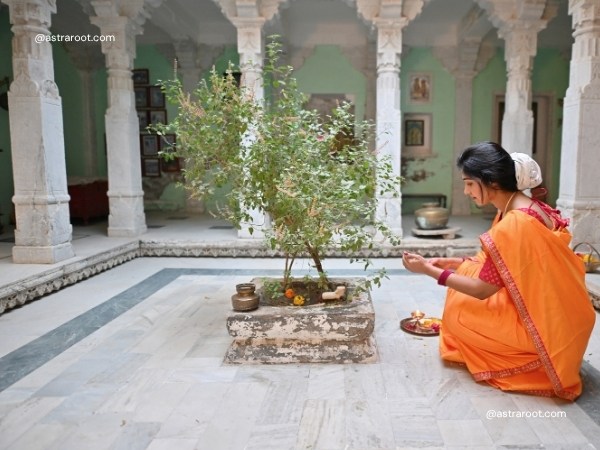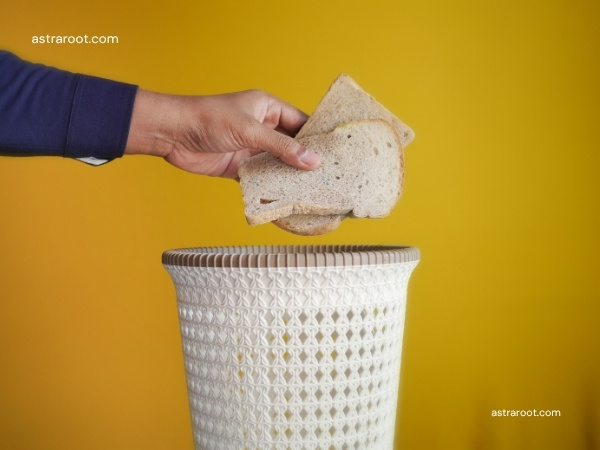Tulsi Plant Vastu – Directions and Tips
In this complete guide, learn the best direction for Tulsi plant Vastu, tips where not to keep it, and how to care for it to ensure your home stays high in vibrations and aligned with nature’s energies.
Wondering where to place your Tulsi plant for maximum positive energy? In Vastu Shastra, the Tulsi (Holy Basil) is more than a sacred herb — it’s a powerful energy purifier that protects your home from negativity, enhances spiritual growth, and attracts peace, prosperity, and good health. But the benefits only flow when Tulsi is placed in the right direction and manner.
🌱 Why Tulsi Plant is Sacred in Vastu
The Tulsi plant (Ocimum sanctum) is more than just an herb; it’s considered a living deity in Vastu and Hindu traditions.
- Spiritual Purity: Known for its purifying properties, Tulsi is believed to cleanse the environment of negative energies and harmful vibrations.
- Health & Well-being: Beyond Vastu, Tulsi is a medicinal powerhouse, revered in Ayurveda for its numerous health benefits.
- Attractor of Wealth: As an incarnation of Goddess Lakshmi, correct Tulsi placement as per Vastu is believed to open channels for wealth and abundance.
- Protective Shield: It acts as a shield against evil spirits and negative influences, fostering a protective ambiance around your home.
- Harmonizer of Energies: Tulsi balances the energies within a space, promoting peace, happiness, and familial harmony.
A well-placed Tulsi plant in home attracts health, harmony, prosperity, and protection from negative forces.

🧭 Best Direction to Keep Tulsi Plant as per Vastu
The direction where you place your Tulsi plant is the single most important factor in its Vastu compliance. Getting this right ensures you tap into its powerful positive vibrations.
✅ North-East (Ishan) – Most Auspicious
Northeast is highly recommended direction for a Tulsi plant as per Vastu. The Northeast is the sacred “Ishaan Kon,” ruled by Lord Shiva and associated with water and divine energy.
- North-East direction is ideal for placing the Tulsi plant.
- It aligns with water and spiritual energy, making it highly favorable.
- Ensures mental peace, spiritual growth, and protection from negativity.
✅ North Direction
The North direction is governed by Lord Kubera, the deity of wealth. Placing your Tulsi plant here acts as a magnet for financial prosperity, career opportunities, and overall abundance.
✅ East Direction
The East is the direction of the rising sun and Lord Indra, symbolizing new beginnings and vitality. Keeping Tulsi here brings good health, positive energy, and keeps negativity at bay.
🪴 Pro Tip: Keep the Tulsi pot or plant on a raised platform or pedestal for spiritual alignment.
Directions to Strictly AVOID for Tulsi Plant Placement:
❌ South Direction
This direction is associated with Lord Yama (the deity of death) and ancestors. Placing Tulsi here can attract negative energy, losses, and unhappiness. It’s generally a strict no-go.
❌ Southwest Direction
This corner represents stability, but Tulsi’s vibrant, sattvic energy might clash with the heavy, earthy energy of Southwest, leading to instability or negativity.
❌ West Direction
While not as problematic as South or Southwest, the West direction is generally not considered ideal for Tulsi, as it can sometimes hinder prosperity or growth.
Where to Place Tulsi Plant: Indoor vs. Outdoor Vastu Tips🏠
The location within your home also matters when considering Tulsi plant Vastu.
✅Outdoor Tulsi Plant Vastu Placement
- Courtyard / Garden: The traditional and most auspicious place for a Tulsi plant is in the central courtyard or garden of your home. This allows it to interact freely with cosmic energies.
- Tulsi Chaura / Vrindavan: Many homes feature a raised, brick or concrete structure (a “Tulsi Chaura” or “Vrindavan”) specifically designed for the Tulsi plant. This elevates its status and creates a sacred space. Ensure the Chaura faces North, Northeast, or East.
- Open Space: The area around the Tulsi plant should be open, clean, and uncluttered to allow free circulation of positive energy.
Indoor Tulsi Plant Vastu Placement
While primarily an outdoor plant, smaller Tulsi plants can sometimes be kept indoors with careful consideration:
- Near Windows: If keeping indoors, place it near a window facing North, Northeast, or East to ensure it gets adequate sunlight and positive energy.
- Avoid Bedrooms: Do not keep the Tulsi plant inside a bedroom. Its strong spiritual energy can sometimes interfere with the energy of rest and intimacy required in a bedroom.
- Living Room/Pooja Room: A small Tulsi plant can be placed in the living room or Pooja room, provided it’s in the designated auspicious directions.
- Balcony: Place tulsi plant in a balcony facing North, Northeast, or East is an excellent alternative for apartment dwellers. Ensure it receives enough sunlight and air.
❌ Avoid These Tulsi Plant Vastu Mistakes
- ❌Never keep the Tulsi plant near a toilet, garbage area, or drain.
- ❌ Don’t keep Tulsi inside the bedroom or bathroom — it disrespects its sacred status.
- ❌ Avoid placing the plant directly on the ground or in metal pots.
- ❌ A dry, wilted, or dying Tulsi plant can create stagnant or negative energy.
- ❌ Never place Tulsi under a staircase or in a shadowy corner.
🌿 Benefits of Keeping Tulsi Plant as per Vastu
Adding a Tulsi plant to your home isn’t just spiritual — it’s transformational. Here are some powerful vastu-based benefits:
- 🌞 Purifies the environment by absorbing toxins and emitting oxygen.
- 🧘 Promotes peace and calm by balancing the air and ether elements.
- 💸 Attracts wealth and prosperity when placed in auspicious directions.
- 🛡️ Acts as a shield against negative energies and evil influences.
- 💖 Enhances family harmony and improves relationships.
To further enhance your home’s positive energy, explore our guide on Vastu Plants Tips for home.
Which Tulsi plant is best for home?
When it comes to inviting positive energy, both the revered Rama Tulsi and the equally powerful Shyama Tulsi varieties are excellent choices for your home.
While widely popular for their medicinal benefits, the vibrant green ‘Holy Basil’ (Rama Tulsi) is the most commonly found and highly cherished for its auspicious Vastu presence across India, among other powerful variants.
- Rama Tulsi (Shri-Tulsi / Green Tulsi): Often called ‘Shri-Tulsi’ or ‘fortunate Tulsi,’ it’s believed to bring immense prosperity, wealth, and general family happiness. It symbolizes good fortune and is widely used for religious purposes and healing. Its taste is generally sweeter.
- Shyama Tulsi (Krishna-Tulsi): Associated deeply with Lord Krishna due to its dark hue, Shyama Tulsi is believed to promote peace, health, and spiritual clarity. It is particularly effective in removing Vastu Doshas (defects) and fostering harmony within relationships. It has a slightly pungent taste and strong medicinal properties for various ailments.
- Kapoor Tulsi: While not as commonly used for ritualistic worship as Rama or Shyama, Kapoor Tulsi is valued for its ability to purify the air and its strong aromatic smell acts as a natural insect and mosquito repellent, contributing to a healthy home environment.
- Vana Tulsi: Its “wild” nature and protective qualities. While less common for indoor Vastu, it offers robust general protection to the surroundings.
Important Vastu Rule: Odd Number of Tulsi Plants
Always keep your Tulsi plants in odd numbers (e.g., 1, 3, 5, 7, etc.) within your home. This is considered highly auspicious for optimizing positive energy flow and benefits.
🛕 Can You Keep Tulsi Plant in Pooja Room?
✅Yes, if your pooja room faces North-East or East, you can keep a small Tulsi pot inside. However, ideally, it should be placed outside the house in open air for spiritual and health benefits.
🧩 Tulsi Plant Vastu Tips – Quick Summary
- ✅ Keep Tulsi in North, North-East, or East direction.
- ✅ Place it on a pedestal or Tulsi vrindavan.
- ✅Pruning: Regularly prune dead or yellowing leaves.
- ✅ Avoid placing it in South, South-West, or under staircases.
- ✅ Water and worship the plant regularly.
- ✅ Never keep a dead or dried Tulsi plant at home.

Religious Significance of Tulsi Plant Vastu
- Central to Pooja: Essential in various Hindu worship rituals and ceremonies.
- Holy Ingredient: Leaves are a key component of Panchamrita, a sacred offering.
- Divine Offering & Adornment: Leaves are offered to deities and used to make garlands (mala) for their adornment (Alankaran ceremony).
- Tulsi Mala for Mantras: Vaishnavas (Vishnu devotees) often wear Tulsi malas while chanting to generate positive vibrations. Wearing a Tulsi Mala around the neck or wrist is believed to purify the body and mind, attract divine blessings, and promote peace and health.
- Tulsi Vivah: The ceremonial marriage of Tulsi with Lord Vishnu (Saligram) signifies deep spiritual union and is highly auspicious, celebrated annually. Its practice is believed to bring immense marital bliss and prosperity to the family.
- Tulsi Wood: Using articles made of Tulsi wood, such as beads, small idols, or even furniture, is considered sacred and helps purify the surrounding energy, bringing calm and positive vibrations to the space.
Mythological Significance of Tulsi
The Tulsi plant is incredibly important in Hindu stories and beliefs. People respect it deeply because of old tales involving gods and goddesses. Many believe it’s like Goddess Lakshmi herself, and Lord Vishnu loves it very much.
There’s a famous story that shows just how powerful Tulsi is: it’s called the Tulabhara incident, featuring Lord Krishna. In this tale, Lord Krishna sat on one side of a huge weighing scale. His queen, Satyabhama, put all her precious gold and jewels on the other side.
But even with all that wealth, Krishna was too heavy – the scale wouldn’t move! Then, his other queen, Rukmini, gently placed just one Tulsi leaf on the scale. She did it with pure love and devotion. Amazingly, that tiny leaf instantly balanced the scale, proving its immense spiritual value.
This powerful story shows that to God, a simple Tulsi leaf offered with true devotion is incredibly precious. That’s why Tulsi holds such a special and worshipped place in Hindu homes.
FAQs on Tulsi Plant Vastu
Q. Where should I keep Tulsi plant at home as per Vastu?
A. Ideally in the North-East, North, or East direction — preferably outdoors in sunlight.
Q. Can I keep Tulsi plant inside the house?
A. While possible, it’s not ideal. Tulsi thrives and radiates positive energy best when placed outside, under open sky and light.
Q. Is it OK to keep Tulsi in the South direction?
A. No, the South is ruled by the fire element and is not suitable for Tulsi. It may block prosperity and peace.
Q. What type of pot is good for Tulsi?
A. Use earthen or clay pots, or a traditional Tulsi vrindavan. Avoid metal or plastic pots.
Q. What if the Tulsi plant dries or dies?
A. Remove it respectfully. Plant a new one. A dead Tulsi plant can attract negative energy and reduce spiritual vibration.
Q. Is it good to keep Tulsi plant in front of the house?
A. Yes, keeping a Tulsi plant in front of the house (especially in the North, Northeast, or East direction) is considered highly auspicious and acts as a protective shield for the home.
Q. What does a dry or dying Tulsi plant signify?
A. A dry or dying Tulsi plant is considered inauspicious in Vastu, often indicating potential challenges or a drain of positive energy. It should be respectfully replaced with a new, healthy plant.
Q. Can Tulsi leaves be plucked on Sundays?
A. No, Tulsi leaves should not be plucked on Sundays, Ekadashi, Full Moon, New Moon days, or after sunset.
Conclusion
Keeping a Tulsi plant vastu is one of the simplest yet most powerful ways to elevate your home’s energy. This sacred herb not only promotes spiritual purity but also attracts divine blessings, harmony, and protection when placed correctly.






